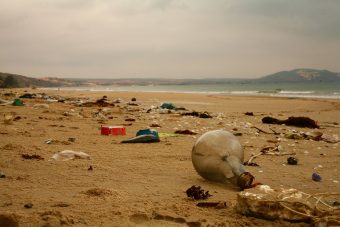
People are primarily concerned about the pollution of the sea by visible plastic floating on the surface of the water, but what should worry us, even more, is the sunken plastic waste that remains on the seabed forever.
In collaboration with their peers from the University of Toronto, researchers from the Australian National Science Agency (CSIRO) estimate that up to 11 million tons of plastic waste are at the bottom of the oceans.
As they state in their research, published in the Science Direct scientific journal, plastic equivalent to the volume of an average garbage truck is dumped into the ocean every minute. With plastic use expected to double by 2040, understanding how and where it travels is critical to protecting marine ecosystems and wildlife, scientists say.
Dr Denise Hardesty from the CSIRO said that that is the first scientific estimate of the amount of plastic waste accumulating on the ocean floor before it is broken into smaller pieces and mixed into ocean sediment.
“We know that millions of tons of plastic waste enter our oceans every year, but what we didn‘t know was how much of this pollution ends up at the bottom of the oceans”, Dr Hardesty said.
MORE:
- RECORD REDUCTION OF 2023 ETS EMISSIONS DUE LARGELY TO BOOST IN RENEWABLE ENERGY
- EIGHT WAYS TO OVERCOME THE WASTE POLLUTION CRISIS
- WHICH KIND OF PACKAGING WILL BE INCLUDED IN THE EU’S LIST OF BANNED PRODUCTS?
While assessments of the amount of microplastics deposited on the seabed have been made before, this research looks at larger items, from nets and cups to plastic bags and everything in between.
Alice Zhu, the study leader and a scientist at the University of Toronto, said the estimate of plastic pollution on the ocean floor could be up to 100 times higher than the amount of plastic floating on the surface of the water.
“The ocean surface is a temporary resting place for plastic, so the expectation is that if we can stop plastic entering our oceans, its amount will be reduced. However, our research found that plastic will continue to end up in the deep ocean, which becomes a permanent resting place for marine pollution by plastic”, said Ms Zhu.
Scientists have constructed two predictive models to estimate the amount and distribution of plastic on the ocean floor – one based on data obtained with remotely operated underwater vehicles (ROVs) and the other from underwater nets.
Using ROV-generated data, it is estimated that 3 to 11 million tons of plastic waste are on the ocean floor. The results also reveal that plastic mass is clustered around the continents – about half (46 per cent) of the plastic on the ocean floor is found at depths above 200m, while ocean depths from 200m to as much as 11,000m contain the rest (54 per cent).



